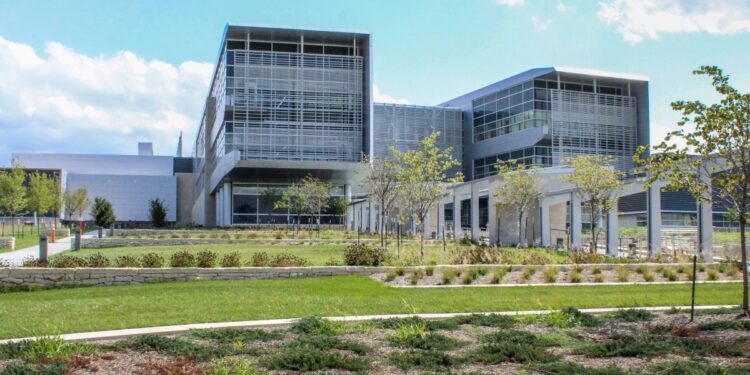McCarthy Building Companies and Mortenson have completed the construction of a $1.06 billion National Bio and Agro-Defense Facility in Manhattan Town, Kansas. This facility is intended to be the top animal disease research centre in the United States, covering an area of 48 acres and having 707,000 square feet of space. The facility replaces the Plum Island Animal Disease Center in Orient Point, New York that was deteriorating and posing a risk to public health and the country’s food supply.
The facility has a biosafety containment system that can maintain a biosafety level 4, which is the highest classification. It is the first biodefence station in the US that can accommodate and maintain large livestock. The laboratory area of the Kansas facility spans 574,000 square feet. The animal containment laboratories provide safety measures so that researchers can investigate a variety of high-risk animal infections safely. The facility can also aid in creating potential vaccines and diagnostic tools and develop countermeasures for veterinary medicinal purposes.
The Department of Homeland Security ordered the construction of this facility in Kansas. Its design incorporated strict confinement, blast resistance, and anti-terrorism requirements, along with a high-wind standard from the Nuclear Regulatory Commission. The facility, eventually run by the Department of Agriculture after a transition period, has an 87,000-square-foot central utility plant that contains boilers, chillers, and emergency diesel generators.
Benefits of the National Bio and Agro-Defense Facility in Kansas
- Protection of the public’s health
- Ensuring the safety and security of the country’s food supply
- Creation and production of potential vaccines, diagnostic tools and countermeasures for veterinary medicinal purposes
- Treatment potential for high-risk animal infections
Dr Dimitri Kusnezov, the DHS Under Secretary for Science and Technology, has stated that “the new facility’s mission is to safeguard the United States against transboundary, emerging, and zoonotic animal diseases that threaten the food supply, agricultural economy, and public health.” The United States Department of Agriculture (USDA) and S&T have collaborated to build this facility since 2005.
Frequently Asked Questions
What is the purpose of the National Bio and Agro-Defense Facility?
The purpose of the National Bio and Agro-Defense Facility is to provide the highest level of animal disease research, protecting the public’s health, ensuring the country’s food supply safety and security, and researching high-risk animal infections. Additionally, the facility will create potential vaccines, diagnostic tools, and countermeasures for veterinary medicinal needs.
What is the biosafety containment system of the National Bio and Agro-Defense Facility?
The biosafety containment system of the National Bio and Agro-Defense Facility is capable of maintaining a biosafety level 4, which is the highest classification possible. It is the first biodefence station in the United States that can handle large livestock while maintaining a safe environment for researchers.
Who funded and managed the construction of the National Bio and Agro-Defense Facility?
The Department of Homeland Security requested and oversaw the construction of the facility, which was completed by McCarthy Building Companies and Mortenson. The Department of Agriculture will manage the facility after a transition period.
What safety features do the design of the National Bio and Agro-Defense Facility incorporate?
The design of the National Bio and Agro-Defense Facility incorporates strict confinement, blast resistance and anti-terrorism requirements, along with a high-wind standard from the Nuclear Regulatory Commission.



